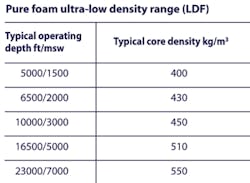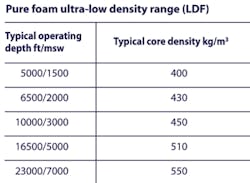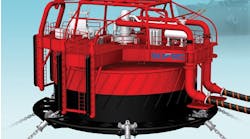Bouchra Delille
Mentor Subsea Technology Services, a J. Ray McDermott company.
The global energy production and transmission infrastructure continues to age. Owners and operators have to decide about the maintenance and repair of these systems.
At the same time, reliance on continued safe operation increases. This need is particularly true for subsea assets, where vessel and ROV availability is a concern.
Integrity management (IM) addresses this dilemma as a continuous process throughout the life of an asset to ensure that it operates as efficiently as possible within acceptable safety margins. In some cases, IM also optimizes and extends an asset’s life.
A comprehensive IM program is complex to establish and to implement. “Blanket” IM plans do not encompass the unique aspects of each asset. To be effective and to generate maximum impact, an IM plan should drive ongoing operational processes such as inspection and maintenance. This typically involves gathering information on the original system design, analyzing data obtained during inspections or monitoring surveys, and comparing the data to the original design.
Developing a semi-quantitative risk assessment model helps prioritize scheduled or remedial actions such as future inspections, cleaning schedules, leak detection programs, and corrosion control strategies. Using a risk-based approach, areas and components where the risk is highest or consequences of a failure are most significant are identified so that efforts can focus on them.
A dynamic approach also uses software support and seeks to stay current and take account of the latest technologies and improvement opportunities (smart pigs, lessons learned, root cause analysis, and others).
Traditionally in the oil and gas industry, inspection activities were done regularly without consideration of the actual condition of the assets or infrastructure. The intervals between inspections were based on qualitative judgment or were mandated by government regulations, usually only after their value has been established by industry practices.
Unfortunately, a number of failures occur even with shorter inspection intervals, mainly because Inspection, Maintenance, and Repair (IMR) activities are not always timely, appropriate, and prioritized. Recently, the oil and gas industry has chosen IM as a process to mitigate these failures to optimize safe, economical operations.
A successful IM program requires comprehensive knowledge of the asset, including its actual condition as well as a rigorous risk-based IMR strategy. One without the other invites failure, and together, they exponentially increase the chances of optimizing integrity.
Knowledge of the asset means having an effective data collection and management system to document failures and consequences such as corrosion, fatigue, and third-party damage.
Risk-based strategy refers to transforming IMR activities into targeted exercises with results incorporated back into the IM plan to emphasize high-risk areas and reduce inspections in low-risk areas to optimize costs.
Probability variables and consequence variables both are examined in most IM plans, consistent with the most widely accepted definition of risk:
Risk = Likelihood or Probability of Failure x Consequences of Failure.
Risk increases if either the probability of failure increases while the consequence of failure remains the same, or the consequences of failure increase with a constant probability of failure, or both variables increase in value. The goal of the Risk-based Strategy is not to make risks disappear, but to minimize them to acceptable levels by decreasing the probability of failure and, if possible, its consequences.
A balanced approach to IM through five components: Risk Modeling, Inspection, Maintenance, Assessment, and Repairs as shown in the diagram at right is a key focus for successful IM management.
The first step in compiling an IM plan is to build a risk model that defines (and then processes) the data regarding the various threats that might harm the asset.
The second step is to plan inspections in order to “observe” or collect data on the potential causes of failures (corrosion, dents, third-party damage).
The third step establishes new “barriers to failure” that decrease the likelihood failure (some of these barriers were considered during design/construction).
The fourth step assesses the effectiveness of these barriers. If part of the asset is damaged, it is repaired, documented, and investigated. Then, actions are taken to avoid the same type of incident in the future, and the risk model is updated if necessary.
This dynamic process is performed in a way that allows assets to operate safely and cost-effectively, both short- and long-term. Extending the asset’s life is one of IM’s most important priorities.
Despite the advancements in technology, even the most sophisticated Risk Model cannot detect or predict all precursors for failure.
When failure does occur, repairs are the action required to resolve integrity concerns after failure (such as recoating or pipe replacement), as well as the investigation of causes and determination of consequences of failure. Regardless of the severity or the cause of the failure, the event can be used to improve IM practices to make the most of any unfortunate event. Without knowing the source of the failure, it is impossible to prevent a reoccurrence either on that part of the asset or any similar ones.
The results of these investigations are combined and considered in light of the IM plan to prevent the same or a similar type of accident from occurring. This eventually adds new barriers or modifies existing ones in the Swiss Cheese Model.
Sometimes, even after investigations, the cause of failure remains unknown. In such cases, the solution is collaboration among industry professionals on these issues through conferences or workshops.
Also, the total costs of a failure can be a powerful ally for the IM Plan. Once the true cost of an incident is known, it is incorporated into the calculation of failure consequences and used to estimate the risk of failure. Calculating or updating the risk of failures will refine the IM plan and educate management and other stakeholders on their real costs. This is important to ensure enough resources are available to implement changes or improvements to the IM plan.
Conclusion
There is no single approach to reach the best solution for IM of all offshore structures. All solutions, however share the goal to enhance safety and environmental protection, and to optimize costs related to operating and maintaining assets, as well as to extend their life cycles.
Most companies already are dedicated to ensuring that employees have a safe workplace and the training and tools to do their jobs. An effective IM plan reduces the number of accidents to limit civil and criminal liabilities.
The greatest challenges most operators face today is to extend the life of old platforms that have reached the end of their designed lifetime, as safely as possible, and to obtain approvals from statutory authorities.
For this reason, operators should include a framework for life extension within the IM plan. A live Risk Model provides a base to evaluate life-span potential and future IMR requirements. An effective Risk Model identifies the most appropriate future actions and develops schedules to maintain the long-term integrity of the asset.
Sometimes IM is seen as an expensive necessity to comply with regulations and not as a way to keep the company’s assets safe and cost efficient. This may be true if the budget is not spent wisely. However, when the IM plan is effective, savings become possible by avoiding long shutdowns for repairs and costly excavations. Many studies show the cost efficiency of a rigorous IM Plan even if it is difficult to quantify the return on investment. These benefits usually come from avoiding costs associated with failure, such as public safety, environment-related, property damage, loss of production and reputation.
IM is a complex improvement process that is continuously updated on the basis of acquired data and information. The strategy to develop and implement IM programs is unique for each offshore operator. Typically, the IM approach is a function of operational experience, corporate philosophy, and mandates for asset management. To accrue all the benefits that operators are seeking, the IM process must be flexible, predictive, and proactive. Fundamentally, it must encapsulate some form of continuous-improvement loop (plan, do, review, improve) and be capable of critical self-analysis to complete the tasks required to close the loop.
Integrity management in action
An example of the importance of inspection as part of the IM plan involves a project J. Ray McDermott carried out that required ROV buckets on pipeline end terminations (PLETs).
These components allow the ROV to lock the PLET to the suction pile once the PLET has been stabbed and connected to the pile. When torque is required subsea to actuate a mechanical device, the ROV applies this torque through a hydraulic torque tool powered from the ROV.
The torque tool docks into a standard API ROV bucket (17D), which allows the transmission of torque to the part. It has slots machined into the side of the bucket that engage a reaction point for the torque application.
On this project, it was discovered during an interface test – after the PLET was already completed – that the reaction slots had been machined incorrectly in the buckets that were purchased as a separate assembly.
Without performing the interface test between the bucket and the torque tool, the PLET would have been on the ocean floor unable to lock to the pile. As a result, approximately 30 quad-joint welds would have had to be cut out, the bucket would have had to be sent in for re-machining and 4,000 ft (1,219 m) of flowlines would have had to be reinstalled.
Even without realizing this worst-case scenario, significant costs were incurred to fix the problem after accepting the parts and installing them onto the PLETs.
A receiving inspection process, however, ensures that the part meets all the requirements as ordered. Preferably, this inspection should take place prior to shipping, as part of a factory acceptance test (FAT) at the supplier facility. A requirement for a FAT should be reflected at the outset, in the request for quotes, as well as in the requisition and purchase order. The cost of inspection is low compared to the consequences of accepting components that do not meet design specifications.




